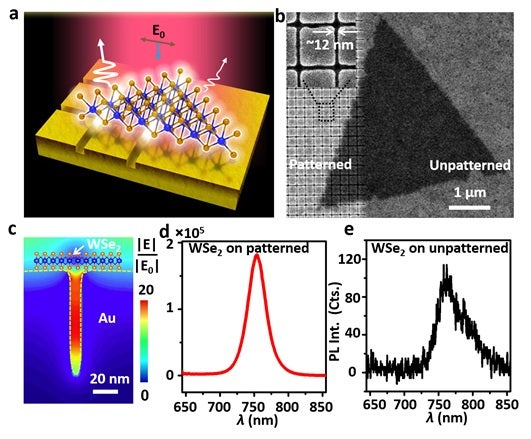Giant photoluminescence in monolayer tungsten diselenide
Andrew WEE (Group Leader, Physics) () May 09, 201609 May 2016 NUS physicists have shown that giant photoluminescence (PL) enhancement is demonstrated by suspending the two-dimensional (2D) semiconductor WSe2 on sub-20 nanometre (nm) wide trenches in gold nanoarray substrates.
Atomically thin (monolayer) 2D transition metal dichalcogenides (TMDCs) have promising applications in photonic devices as they are often direct band gap semiconductors. However, being atomically thin limits their practical applications due to low absorption and PL. The 2D semiconductor WSe2 was chosen as it has a quantum yield two orders of magnitude larger than that of 2D molybdenum disulphide (MoS2), the most common 2D TMDC semiconductor studied. A team led by Prof Andrew WEE, together with his Ph.D. student, Ms WANG Zhuo, from the Department of Physics in NUS, in collaboration with researchers from the Singapore University of Technology and Design (SUTD) and Imperial College UK, has demonstrated the enhancement of PL in 2D WSe2 by judiciously designed nanostructures and by exploring the PL enhancement mechanism in TMDCs.
A typical 2D semiconductor WSe2 has a higher quantum yield than that of MoS2. It is generally more challenging to achieve large PL enhancements from systems with a higher quantum yield. The work of Wang et al addressed this challenge and successfully obtained PL enhancements of ~20,000-fold in WSe2-gold plasmonic nanostructures, which is one order larger than that previously obtained in MoS2-metal nanostructures (thousand-fold). Plasmons are collective excitations of electrons in solids that interact strongly with light. The key to this work is the design of the gold plasmonic nanoarray templates.
This research demonstrates the feasibility of giant PL enhancements in WSe2 with judiciously designed lateral plasmonic nanostructures and paves the way towards the implementation of plasmon-enhanced transition metal dichalcogenide photodetectors, sensors and emitters. This hybrid plasmon-enhanced design also provides full access to the top surface of WSe2, e.g. for layering of other 2D materials, electrical top contacts, chemical doping, or optical waveguiding. This work also demonstrates that fabricated gold nanoarrays with sub-20 nm trenches can efficiently increase light-matter interaction in WSe2, opening up a new platform for investigating novel electrical/optical properties in the gold/ WSe2 hybrid system. The next step of this research project is to investigate the effectiveness of the lateral gold plasmons in enhancing the second harmonic generation and electroluminescence of TMDCs.

Figure shows the schematic of WSe2-gold plasmonic hybrid structure with strong optical absorption and PL enhancement. The PL of WSe2 on patterned gold substrate is enhanced 1,810-fold compared with that of WSe2 on unpatterned gold substrate. As PL enhancement is predominately localised at the trenches perpendicular to the polarisation direction of the illumination laser, it can be calculated that the PL enhancement of WSe2 over the trench is enhanced 20,000 compared with that of the reference sample. (a) Schematic of PL emission from a single crystal monolayer of WSe2 flake on a gold substrate. Part of the triangular flake rests on the patterned region of the substrate consisting of sub-20 nm wide trenches. (b) Representative Scanning electron micrograph (SEM) image of WSe2 on square arrays with a trench width of 12 nm (Patterned) and unpatterned gold film (Unpatterned). (c) Representative simulation of the electric field distribution of the lateral gap plasmons with a WSe2 monolayer flake suspended over a single trench. The polarisation of the incident laser field is across the gap. The dashed yellow line denotes the boundary between air and gold. PL spectra of WSe2 on patterned (d) and unpatterned gold substrate (e). [Image credit: Andrew Wee and Zhuo Wang]
Reference
Z Wang, Z Dong, Y Gu, YH Chang, L Zhang, LJ Li, W Zhao, G Eda, W Zhang, G Grinblat, SA Maier, KW Yang, CW Qiu, A Wee. “Giant photoluminescence enhancement in tungsten–diselenide–gold plasmonic hybrid structures” Nature Communications 7 (2016) 11283 doi:10.1038/ncomms11283.


